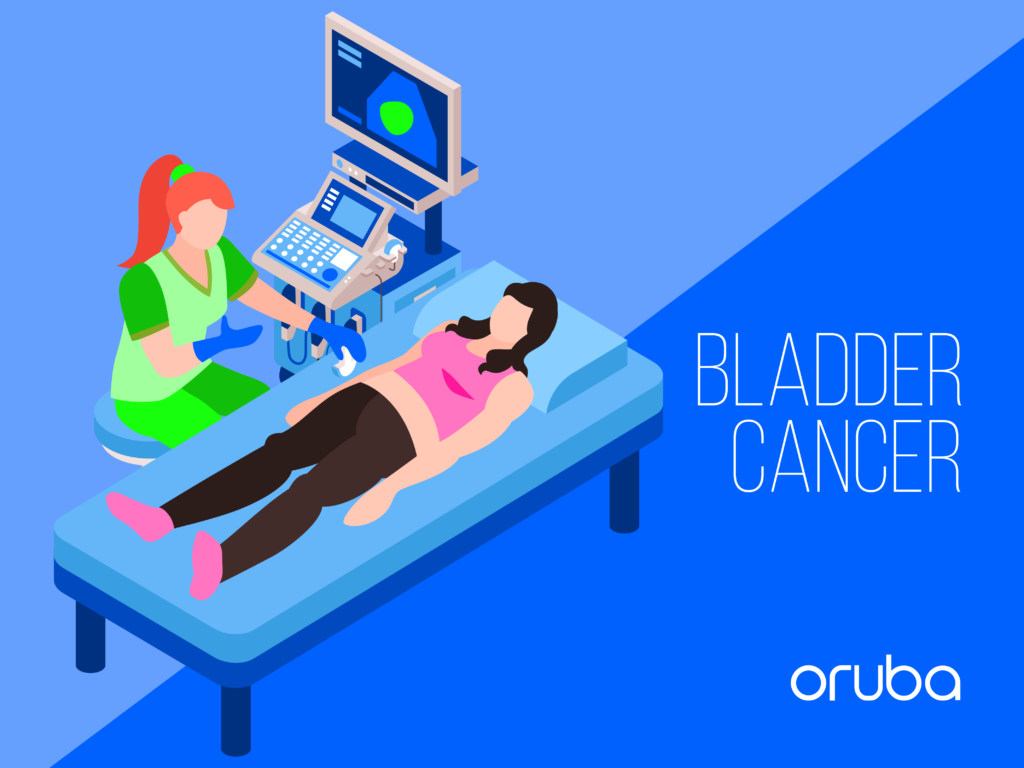What is bladder cancer?
Bladder cancer is an abnormal growth of cells in the bladder, which expands the bladder. Bladder cancer is one of the most common types of cancer and mostly affects people over 50 years of age. People at high risk are those who have been exposed to chemotherapy agents, diesel exhaust fumes, and other chemicals for a long period of time. Cancer of the urinary bladder develops when cells that make up the urinary bladder begin to grow in an uncontrolled manner. As more cancer cells develop, they have the potential to form a tumor, which then, over time, has the ability to spread to other areas of the body.
Bladder cancer is any of several types of cancer arising from the tissues of the urinary bladder. It is a disease in which cells grow abnormally and have the potential to spread to other parts of the body. Symptoms include blood in the urine, pain with urination, and low back pain.
The hollow organ that makes up the bladder is located in the lower pelvis. It has pliable, muscular walls that can stretch to hold urine and then squeeze to expel it from the body. This organ is located in the urinary tract. Urine storage is the primary function of the bladder. Urine is a liquid waste product that is produced by both kidneys and then transported to the bladder by means of two tubes known as ureters. Urination involves the contraction of the muscles in the bladder, which results in the passage of urine from the bladder through a tube known as the urethra.
Bladder cancer symptoms
Bladder cancer symptoms can be caught early. When it comes to bladder cancer, it is important that one gets to know about the symptoms at an early stage to avoid any serious problems. So, the question is, how do you know if you have bladder cancer? The symptoms of bladder cancer can be mistaken for less serious conditions, so it’s essential to get them checked by a professional. Bladder cancer may not cause any signs or symptoms in its early stages because the bladder is usually empty when a person goes to the toilet. Here are a few common symptoms that one must know:
- There are either blood or blood clots present in the urine
- When urinating, you may feel pain or a burning sensation
- Frequent urination
- Having a strong urge to urinate multiple times throughout the night
- Having the sensation that one needs to urinate but being unable actually to do so
- Pain in the lower back, but only on one side of the body
The presence of blood in the urine is also known as hematuria. It is the single most important factor in determining whether a person has bladder cancer or not. Gross hematuria is a condition in which there is sufficient blood in the urine for the patient to be able to detect it visually. There is also the possibility that the urine contains trace amounts of blood that cannot be seen by the naked eye. This condition, which is only detectable through a urine test, is referred to as “microscopic hematuria.”
It is possible that cancer has already spread to another part of the body when the first symptoms of bladder cancer manifest. In this situation, the manifestation of symptoms is determined by the stage and location of cancer. Cancer that has spread to the bone may cause bone pain or a fracture. Cancer that has spread to the lungs may cause coughing or shortness of breath. Cancer that has spread to the liver may cause abdominal pain or jaundice (yellowing of the skin and whites of the eyes). Pain in the back or pelvis, loss of appetite for no apparent reason, and a general decrease in body mass may also be associated with advanced bladder cancer.
Warning signs of bladder cancer
If you are aware of the warning signs and symptoms, you may be able to receive a diagnosis faster, which could improve your prognosis. The following are five warning signs of bladder cancer to keep an eye out for:
1. Presence of urine in the blood (hematuria)
This is the most common early symptom of bladder cancer and is typically the first sign that a person notices that they may have bladder cancer. It is typically painless, and there may be several weeks or even months that pass between episodes, so it is easy for women to ignore it when it occurs. The fact that many women attribute this symptom to menstruation or menopause leads many of them to ignore it.
2. Facing UTI-like symptoms
Consultation with a urologist who specializes in UTI-like symptoms is your best option if you are unsure whether or not there is a problem. Due to the fact that many of the symptoms of both conditions are similar, it is possible to confuse bladder cancer with a Urinary Tract Infection (UTI). Patients might experience urinary incontinence, pain during urination, increased frequency and urgency of urination, and increased frequency of urination overall. Talk to your primary care physician if you have any urinary issues, such as a frequent need to urinate, the sensation that you need to urinate but are unable to, difficulty emptying your bladder, or if antibiotics do not appear to be alleviating the symptoms of your urinary tract infection (UTI).
3. Having pain that cannot be explained
Pain is a common symptom of bladder cancers that have advanced to a later stage. Pain might be felt in the flank region, in the abdomen, or in the pelvis. Patients who are suffering from cancer that has spread to their bones may also experience pain in their bones. Tell your doctor if you are experiencing aches and pains in those areas; this is especially important if you have also noticed spotting or other symptoms of a UTI.
4. Reduced hunger
Loss of appetite is a symptom of many different types of cancer, and bladder cancer is no exception. You may experience a loss of weight, as well as feelings of exhaustion and weakness if the cancer has grown or spread. Postmenopausal bleeding in the uterus, of course, there are plenty of other things that can mess with your appetite, so you shouldn’t automatically assume the worst; however, you should talk to your doctor about it if it persists.
5. Postmenopausal bleeding in the uterus
After menopause, if you notice any blood or spotting, you should get it checked out because it could be a sign of bladder cancer or another underlying issue. The main question here is, where is bladder pain felt? It may be felt in the uterus and lower abdomen. As we all know, the fact that blood in the urine may be easy to overlook, so it is recommended that you visit your urologist just to be on the safe side.
Who is at risk for bladder cancer?
When it comes to bladder cancer, smoking is by far the most important risk factor that should be taken into consideration. The National Institutes of Health reports that approximately 50% of female patients diagnosed with bladder cancer are smokers. If you are a smoker and notice any of the symptoms listed above, you should make an appointment with your doctor as soon as possible. The risk of developing these conditions is significantly increased in people who smoke.
Exposure to radiation in the past is the second most common risk factor (e.g., as a treatment for cervical cancer, prostate cancer, or rectal cancer).
In addition, the use of some chemotherapy medicines, such as cyclophosphamide, has been linked to an increased risk of bladder cancer.
Having had bladder cancer in the past is an additional significant risk factor. The recurrence rate for bladder cancer, which ranges from 50 to 80%, is one of the highest rates seen in any type of cancer. If you have previously been diagnosed with bladder cancer, it is critical that you maintain regular checkups with your primary care physician and remain vigilant for any symptoms of the disease. When in doubt, get it checked out.
Age is yet another important consideration. In most cases, a diagnosis is made when a woman is 73 years old. Any woman over the age of 55 who is concerned about her health should pay special attention to the warning signs.
Environmental exposures are a contributing factor in the development of bladder cancer. Those who work with chemicals, such as aromatic amines, which are compounds used in the production of dyes, put themselves in danger. Extensive contact with rubber, leather, certain textiles, paint, and hairdressing supplies, which is often associated with work exposure, appears also to enhance the risk of developing the condition.
Infection is caused by the blood-sucking parasite Schistosoma haematobium, which is particularly prevalent in underdeveloped nations and the Middle East. (The United States does not have any instances of this bacterium.)
People who have frequent infections of the bladder, bladder stones, or other diseases of the urinary tract or who have a chronic need for a catheter in the bladder may be at a higher risk of developing squamous cell carcinoma. This type of cancer can also develop in people who have a chronic need for a catheter in the bladder. Patients who have had bladder cancer in the past have an elevated chance of developing a new bladder tumor or having an existing bladder tumor return.
Causes of bladder cancer
After reading the above-mentioned topics, one question that might strike your head is how do you get bladder cancer? When cells in the bladder undergo changes (mutations) in their DNA, this is the first step in the development of bladder cancer. The DNA of a cell contains instructions that direct the cells as to what they should be doing. Because of the changes, the cell is given the instruction to multiply quickly and to keep living even though healthy cells would normally die. A tumor is formed by abnormal cells, which have the potential to infiltrate and destroy normal body tissue. After a period of time, the abnormal cells may separate from one another and begin to spread (metastasize) throughout the body.
Types of bladder cancer
Bladder cancer comes in several types. Let’s have a look at each one of them individually:
1. Urothelial carcinoma
The form of bladder cancer known as urothelial carcinoma, which is also referred to as Transitional Cell Carcinoma (TCC), is by far the most common type of bladder cancer. In point of fact, if you are diagnosed with bladder cancer, the type of cancer you have is almost certainly urothelial carcinoma. These cancers begin in the urothelial cells that line the interior of the bladder.
In addition to lining the urethra and ureters, the renal pelvis, which is the part of the kidney that connects to the ureter, urothelial cells also line the other parts of the urinary tract, including the ureters and the urethra. Due to the fact that people who have bladder cancer may also have tumors in these other locations, the entire urinary tract needs to be examined for the presence of tumors.
2. Squamous cell carcinoma
Squamous cell carcinomas account for only about 1–2 % of bladder cancers diagnosed in people globally. When viewed through a microscope, the cells have an appearance that is very similar to that of the fat cells that are located on the surface of the skin. The vast majority of bladder squamous cell carcinomas are aggressive forms of the disease.
3. Adenocarcinoma
Adenocarcinomas make up only about 1% of all cases of bladder cancer. These cancer cells share quite a few characteristics with the gland-forming cells that can be found in colon cancers. The vast majority of bladder adenocarcinomas are aggressive forms of the disease.
4. Small cell carcinoma
A small percentage of bladder cancers, less than 1%, are small-cell carcinomas. They originate in cells that resemble nerves and are known as neuroendocrine cells. Chemotherapy, similar to that used for treating small cell carcinoma of the lung, is typically required for the treatment of these cancers because of their rapid growth rate.
5. Sarcomas
Sarcomas begin in the muscle cells of the bladder, but they are extremely uncommon. Sarcomas can be fatal. A form of cancer that first manifests itself in the bone or in the soft tissues of the body, such as cartilage, fat, muscle, blood vessels, fibrous tissue, or any other connective or supportive tissue. The sites at which cancer initially develops give rise to the various subtypes of sarcoma. For instance, osteosarcoma develops in the bone, liposarcoma in the fat, and rhabdomyosarcoma in the muscle. The treatment plan and outlook are both determined by the type and stage of cancer. Sarcoma can affect people of any age, including children.
The treatment for these less common forms of bladder cancer (other than sarcoma) is very similar to the treatment for TCCs, particularly for early-stage tumors; however, if chemotherapy is required, different drugs may be used.

Does bladder cancer have stages?
Do you think what the stages of bladder cancer are? Here is the answer: your physician can use a staging system for bladder cancer that ranges from stage 0 to stage 4 to determine how far cancer has spread and give you a stage-wise rating. The following descriptions apply to the various stages of bladder cancer:
- Cancer that has not yet spread beyond the lining of the bladder is considered to be in the stage 0 stage. In the initial stage, aberrant cells are discovered in the tissue that lines the interior of the bladder. These abnormal cells have the potential to develop into cancer, which would then spread to the normal tissue that is located nearby. The following types of tumors are classified into stages 0a and 0is according to the American Joint Committee on Cancer Staging System:
- Non-invasive papillary carcinoma, also known as stage 0a, can present as what seems to belong, thin growths coming from the lining of the bladder. These growths may be cancerous.
- A carcinoma in situ, also known as stage 0is, is a benign tumor that forms on the tissue that lines the interior of the bladder. This tumor is flat.
- Cancer of the bladder that has progressed to stage 1 has moved beyond the layer that lines the bladder but has not yet reached the layer of muscle that lines the bladder.
- The bladder cancer has progressed to stage 2 and has spread to the layer of muscle that is found in the bladder.
- Cancer of the bladder has spread to the tissues that surround the bladder if it has progressed to stage 3. The third stage is further subdivided into stages IIIA and IIIB. In stage IIIA, cancer makes its way from the bladder to other layers of fat that surround the bladder and may have spread to the reproductive organs (seminal vesicles, uterus, prostate, or vagina), but cancer has not spread to lymph nodes, or cancer has spread from the bladder to one lymph node in the pelvis that is not near the common iliac arteries. Stage IIIB is when cancer has spread from the bladder to the layer of fat surrounding the bladder and may have spread to the reproductive organs (major arteries in the pelvis).
- Cancer has migrated from the bladder to over one lymph node that is present in the pelvis and is not near the common iliac arteries, or it has spread to at least one lymph node that is near the common iliac arteries when it has reached the stage known as IIIB.
- When bladder cancer has progressed to stage 4, the disease has spread beyond the bladder to other parts of the body. The fourth stage is then broken down into stages IVA and IVB.
- Cancer has migrated from the bladder to the wall of the abdomen or pelvis in stage IVA; alternatively, cancer has spread to lymph nodes that are located above the common iliac arteries in this stage (major arteries in the pelvis).
- Cancer has progressed to other regions of the body, such as the lung, bone, or liver, by the time it reaches stage IVB.
After treatment, bladder cancer occasionally returns in patients. This is referred to as a recurrence. There is a possibility that cancer will return, either in the bladder or in some other part of the body.
The beginnings and progression of bladder cancer
There are several different layers that make up the wall of the bladder. There are several distinct types of cells that make up each layer:
The urothelium, also known as the transitional epithelium, is the layer of the bladder that is considered to be the site of origin for the vast majority of bladder malignancies. When cancer spreads into additional layers of the bladder wall or even through them, it has a higher stage, it is further along in its development, and it may be more difficult to treat.
Over the course of time, cancer may spread from the bladder into surrounding organs and skeletal systems. It is possible for it to spread to lymph nodes in the area, as well as to other parts of the body. (When bladder cancer spreads, it typically goes to lymph nodes that are located further away, as well as the bones, lungs, or liver.)
Invasive vs. non-invasive bladder cancer
Cancers of the bladder are frequently classified according to how far they have spread into the wall of the bladder, as follows:
Invasive Bladder Cancer
Cancers that are invasive have spread further into the deeper layers of the bladder wall. These malignancies have a higher risk of metastasizing and are more difficult to cure.
Non-invasive Bladder Cancer
Cancers that are not invasive are only found in the innermost layer of cells (the transitional epithelium). They have not yet reached the deeper strata of the forest.
In addition to these two classifications, bladder cancer may be superficial or non-muscle invasive. These phrases refer to cancers that have not spread into the major muscle layer of the bladder and encompass both non-invasive tumors and any invasive tumors that have not spread into the main muscle layer.
Papillary vs. flat cancer
On the basis of their growth pattern, bladder tumors are further subdivided into two categories: papillary and flat.
Papillary carcinomas develop in the form of thin projections that resemble fingers and extend from the inner surface of the bladder toward the hollow center. Papillary tumors typically grow in the direction of the center of the bladder rather than expanding into the deeper layers of the bladder. Non-invasive papillary cancers are the medical term for these growths. Papillary carcinoma that is non-invasive and of a very low grade (developing slowly) is sometimes referred to as Papillary Urothelial Neoplasm Of Low Malignant Potential (PUNLMP), and the prognosis for patients with this type of cancer is typically quite optimistic.
Flat carcinomas never grow toward the hollow region of the bladder like other types of bladder cancer do. When a flat tumor is found solely in the inner layer of bladder cells, medical professionals refer to the condition as non-invasive flat carcinoma or flat carcinoma in situ (CIS).
Invasive urothelial carcinoma, also known as transitional cell carcinoma, is a type of urothelial carcinoma that develops when a papillary or flat tumor invades deeper layers of the bladder.
How fast does bladder cancer spread?
There is a possibility that up to 50% of patients diagnosed with muscle-invasive bladder cancer will have occult metastases that will become clinically apparent within five years of the initial diagnosis. Roughly 5% of patients will already have distant metastases at the time of the initial diagnosis. Despite chemotherapy, the majority of patients with overt metastatic disease will pass away within two years. Patients who undergo cystectomy and pelvic lymph node dissection and are found to have only limited regional lymph node metastases have a chance of surviving longer than five years. This chance is somewhere between 25 and 30%. There are two ways that metastasis might take place: either through the lymphatic system, in which case it will most frequently affect the lymph nodes in the pelvis, or through the blood system, in which case it will move to the liver, lung, or bone.
How is bladder cancer diagnosed?
The following tests and methods may be utilized in the diagnostic process for bladder cancer:
- Utilizing a scope to investigate the contents of your bladder from the inside (cystoscopy). A cystoscope is a thin, long tube that is inserted into the urethra by your doctor in order to perform a cystoscopy on you. Your doctor will be able to examine your urethra and bladder for any indications of disease thanks to the lens on the cystoscope, which provides a view of the interior of these organs. Cystoscopy is a procedure that can be performed either in a doctor’s office or in a hospital setting.
- Removing a piece of tissue for the purpose of evaluating it (biopsy). Your physician may take a cell sample (biopsy) for testing by inserting a specialized tool through the scope of the cystoscope and into your bladder while performing cystoscopy on you. The term “Transurethral Resection Of Bladder tumor” may also be used to refer to this technique (TURBT). The treatment of bladder cancer by TURBT is also an option.
- Examining a urine sample (urine cytology). Urine cytology is a process that involves examining a sample of your urine under a microscope to look for any signs of cancer cells.
- Imaging testing: Your doctor will be able to check the anatomy of your urinary system by using imaging tests such as a Computerised Tomography (CT) urogram or a retrograde pyelogram.
A contrast dye is injected into a vein in your hand before you undergo a CT urogram. This dye eventually makes its way through your kidneys, ureters, and bladder. The X-ray images that were acquired during the test provide a detailed view of your urinary tract, which assists your physician in locating any potential cancerous regions in your urinary tract.
An x-ray procedure known as a retrograde pyelogram is performed in order to obtain an in-depth view of the patient’s upper urinary system. During this portion of the procedure, your physician will insert a catheter into your bladder, then thread a small tube (contrast dye) through your urethra, and finally into your ureters. After that, the dye is administered to your kidneys while the X-ray photos are taken.
What tests will I have if my doctor suspects bladder cancer or another urinary problem?
After it has been established that you suffer from bladder cancer, your physician may advise you to undergo further examinations in order to ascertain whether or not the disease has progressed to your lymph nodes or to other parts of your body. Here are the possible tests that can be asked to be taken by your physician:
- CT scan
- Magnetic Resonance Imaging (MRI)
- Positron Emission Tomography (PET)
- Bone scan
- X-ray of the chest
Your cancer will be given a stage based on the information that is gleaned from these procedures by your doctor. Roman numerals ranging from 0 to 4 describe the stages of bladder cancer, which can be found anywhere in the urinary tract. The earliest stages of bladder cancer suggest that the disease has not yet spread to the muscular wall of the bladder and is instead confined to the innermost layers of the bladder. The most advanced stage of cancer, known as stage 4, signifies that the disease has progressed to lymph nodes or organs located in other parts of the body.
Bladder cancer grade
When examined under a microscope, bladder tumors are categorized further according to the characteristics of the cancer cells themselves. This characteristic is referred to as the grade, and depending on its severity, your physician may classify the bladder cancer as either low grade or high grade:
Low-grade bladder cancer
This form of cancer is characterized by cells that more closely resemble normal cells in both appearance and organization (well-differentiated). When compared to a high-grade tumor, a low-grade tumor often expands at a slower rate and has a lower risk of invading the muscle wall that surrounds the bladder.
High-grade bladder cancer
This form of cancer is characterized by cells that have an aberrant appearance and have no similarity to normal-appearing tissues in any way (poorly differentiated). A high-grade tumor has a tendency to grow more aggressively than a low-grade tumor and may have a greater chance of spreading to the muscular wall of the bladder as well as other tissues and organs. This is because high-grade tumors are more likely to be malignant.
Is bladder cancer curable?
The following factors will determine the prognosis:
- The stage at which the cancer is present (whether it is superficial or invasive bladder cancer, and whether it has spread to other places in the body). When detected in its earlier stages, bladder cancer is frequently curable.
- The kind of cells that are affected by bladder cancer and how those cells appear when viewed via a microscope.
- Check to see whether there are any other areas of the bladder that have cancer in situ.
- The age of the patient as well as their overall health.
The prognosis is also determined by the following factors if the cancer is only superficial:
- How many different types of tumors are there.
- The extent of the tumors in the body.
- Whether or whether the tumor has returned after treatment has been administered.
- The stage of bladder cancer influences the treatment choices that are available.

Bladder cancer treatment
Patients who have been diagnosed with bladder cancer can select from a variety of therapy options. You must be thinking, what is the best treatment for bladder cancer? There are five different types of treatment that are considered standard:
- Surgery
- Therapy with radiation
- Chemotherapy
- Immunotherapy
- The use of specific drugs in the treatment
Clinical trials are being used to investigate and test out new treatment methods. There is a possibility that treatment for bladder cancer will create adverse consequences. Patients should give some thought to the possibility of taking part in a clinical study. Patients may enroll in clinical trials at any point prior to, during, or after beginning treatment for their cancer. It’s possible that further testing will be required. Patients who have been diagnosed with bladder cancer can select from a variety of therapy options. Some treatments are considered the gold standard (the treatment that is most commonly used), while others are currently being evaluated in research trials. A clinical trial of treatment is a type of research study that is conducted to assist in the improvement of existing treatments or to acquire information on new treatments for people who have cancer. If clinical tests demonstrate that a new treatment is superior to the treatment that is now being used, then the new treatment might replace the treatment that is currently being used. Patients should give some thought to the possibility of taking part in a clinical study. Patients who have not yet begun treatment may be eligible to participate in some clinical trials.
There are five different types of treatment that are considered standard:
#1 Surgery
It’s possible that you’ll need one of the following kinds of surgical procedures:
1. Transurethral resection (TUR) with fulguration
This procedure involves inserting a cystoscope, which is a thin, illuminated tube, into the bladder through the urethra. After that, a device with a loop of thin wire attached to one end is used to either cut out the cancerous growth or apply high-powered electricity to it in order to destroy it. This process is referred to as fulguration.
2. Radical cystectomy
During a radical cystectomy, the patient’s bladder, along with any lymph nodes and adjacent organs that are cancerous, are surgically removed. When cancer has spread to the muscle wall of the bladder, or when superficial cancer has spread to include a considerable portion of the bladder, this surgery may be necessary. In males, the prostate and the seminal vesicles are the neighboring organs that are removed during this procedure. In female patients, surgical removal of the uterus, ovaries, and a portion of the vagina is performed. In some cases, surgery to remove only the bladder may be performed to treat urinary problems brought on by cancer. This is done when the disease has progressed beyond the bladder and cannot be completely removed. When it is necessary to remove the bladder, the surgeon will design an alternative route for urine to pass out of the body.
3. Partial cystectomy
Patients with a low-grade tumor that has infiltrated the wall of the bladder but is confined to one region of the bladder may be candidates for this surgery. Patients must have a restricted bladder invasion. Patients are able to urinate regularly after recuperating from this surgery since only a portion of the bladder needs to be removed during the procedure. Segmental cystectomy is another name for this procedure.
4. Urinary diversion
Urinary diversion refers to a surgical procedure that creates a new pathway for the body to hold pee and excrete it.
Chemotherapy is a type of treatment that is administered to patients following surgery in order to eliminate any remaining cancer cells. This is done even if the surgeon was successful in removing all visible signs of cancer during the first procedure. Adjuvant therapy is a type of treatment that is administered after primary surgical treatment in order to reduce the likelihood that cancer will return.
#2 Radiation therapy
Radiation therapy is a treatment for cancer that involves subjecting cancer cells to high-energy x-rays or other forms of radiation in order to destroy them or prevent them from developing. The radiation for external radiation therapy comes from a machine that is placed outside of the patient’s body and directed toward the part of the body where the cancer is located.
#3 Chemotherapy
Chemotherapy is a treatment for cancer that involves the use of medications in order to inhibit the proliferation of cancer cells. This can be accomplished in one of two ways: either by killing the cells or by preventing them from growing. The chemotherapy medications are absorbed into the bloodstream when the treatment is either taken orally or injected into a vein or muscle. This allows the drugs to reach cancer cells located everywhere in the body (systemic chemotherapy). When chemotherapy medications are administered in a manner that causes them to be absorbed directly into the cerebrospinal fluid, an organ, or a body cavity such as the abdomen, the drugs have the greatest impact on cancer cells located in those specific locations (regional chemotherapy). Intravesical chemotherapy may be a localized treatment option for bladder cancer (put into the bladder through a tube inserted into the urethra). The type and stage of cancer that is being treated will determine how the chemotherapy is administered to the patient. The use of more than one anticancer agent during treatment is known as combination chemotherapy.
#4 Immunotherapy
Immunotherapy is a form of cancer treatment in which the patient’s own immune system is utilized to combat the disease. In order to strengthen, direct, or restore the body’s natural defenses against cancer, substances that are either produced by the body itself or manufactured in a laboratory are utilized. This approach to treating cancer is a form of therapy known as biologic therapy.
There are several distinct forms of immunotherapy, including the following:
- Treatment with an inhibitor of PD-1 and PD-L1:
On the surface of T cells is a protein called PD-1, which plays an important role in regulating the immunological responses of the body. A protein known as PD-L1 is discovered on many different kinds of cancer cells. When PD-1 binds to PD-L1, it prevents the T cell from destroying the cancer cell. PD-1 is short for programmed death 1. Proteins PD-1 and PD-L1 are prevented from binding to one another by compounds known as PD-1 and PD-L1 inhibitors. Because of this, T cells are able to eliminate cancer cells.
- PD-1 inhibitors come in a variety of forms, including Pembrolizumab and Nivolumab.
- PD-L1 inhibitors come in a variety of forms, including Atezolizumab, Avelumab, and Durvalumab.
- BCG, also known as bacillus Calmette-Guérin, is an immunotherapy that is administered intravenously and is used to treat bladder cancer. The BCG is administered in the form of a fluid that is directly inserted into the bladder through the use of a catheter (thin tube).
Treatment for stages
Let’s have a look at various treatment options available for different stages:
Treatment of the Initial Stage (Noninvasive Papillary Carcinoma and Carcinoma in Situ)
The following are some potential treatments for cancers that have reached stage 0 (non-invasive papillary carcinoma and carcinoma in situ):
- Resection can be performed transurethrally with fulguration. The next thing that could happen is one of the following:
- Chemotherapy is administered intravenously immediately following the surgical procedure.
- Intravesical chemotherapy is administered immediately following surgical excision, followed by ongoing intravenous BCG or intrathecal chemotherapy treatment at regular intervals.
- A cystectomy is just partial
- A comprehensive cystectomy
- Conduction of a new clinical trial
Treatment for Bladder Cancer in Stage I
The following are some of the potential treatments for stage I bladder cancer:
- Resection is performed transurethrally with fulguration. The next thing that could happen is one of the following:
- Chemotherapy is administered intravenously immediately following a surgical procedure.
- Intravesical chemotherapy is administered immediately following surgical excision, followed by ongoing intravenous BCG or intrathecal chemotherapy treatment at regular intervals.
- A cystectomy is just partial
- A comprehensive cystectomy
- Conduction of a new clinical trial
Treatment Options for Bladder Cancer in Stages II and III
The following are some of the potential treatments for bladder cancer in stages II and III:
- A comprehensive cystectomy.
- This is followed by a major cystectomy after treatment with combination chemotherapy. It is possible to make a urinary diversion.
- Surgical removal of the entire cyst, then either chemotherapy or immunotherapy (nivolumab).
- Radiation therapy is delivered from the outside, with or without chemotherapy.
- The patient may get chemotherapy after a partial cystectomy.
- Resection was performed transurethrally with fulguration.
- A test of the effectiveness of a novel treatment in humans.
Treatment for Bladder Cancer in the Stage IV Advanced Stage
The following treatments may be used for patients with stage IV bladder cancer whose cancer has not progressed to any other areas of the body:
- A radical cystectomy, either by itself or in combination with chemotherapy.
- Radiation therapy is delivered from the outside, with or without chemotherapy.
- Urinary diversion or cystectomy as palliative therapy to reduce symptoms and enhance the quality of life in patients with urinary incontinence.
The following methods may be utilized in the treatment of stage IV bladder cancer that has progressed to other areas of the body, such as the lung, the bone, or the liver, respectively:
- Chemotherapy is administered with or in lieu of receiving local treatment (surgery or radiation therapy).
- Immunotherapy / Immunothérapie (immune checkpoint inhibitor therapy).
- Radiation treatment delivered from outside the body is used in palliative care to alleviate symptoms and improve quality of life.
- Urinary diversion or cystectomy is palliative therapy to reduce symptoms and enhance the quality of life in patients with urinary incontinence.
- A phase three clinical investigation investigating novel cancer treatments.
Can you survive without a bladder?
If your bladder has been removed after surgery, you will need to become accustomed to a different manner to eliminate pee from your body. The cystectomy that you have done is a transformation that will last for the rest of your life. It’s possible that you’ll need to modify how you shower as well as how you travel. It is possible for it to have an effect on your body image, and you may be concerned about the effect it will have on your relationships and your sexual life.
You should be able to perform practically everything you did in the past if you give yourself enough time. You are able to return to work, continue your exercise routine, and even go swimming even though you are now required to use a urostomy bag to collect your pee. It’s possible that nobody will even notice you until you bring it to their attention.
Prevention of bladder cancer and risk factors for bladder cancer
There is currently no foolproof method available for preventing bladder cancer. Some risk variables, including gender, age, race, and family history, are unable to be managed by the individual. However, there is a possibility that there are actions you may do that will assist reduce the danger. Let’s have a look at a few of them:
Don’t smoke
It is believed that smoking is responsible for around half of all cases of bladder cancer. (This covers cigarettes, cigars, and pipes, as well as any other form of the smoked product.)
Reduce your exposure to specific chemicals at your place of employment
Workers exposed to certain organic compounds on the job have a significantly increased chance of developing bladder cancer. Industries dealing with rubber, leather, printing materials, textiles, and paint are some examples of places in the workplace where these chemicals are utilized often. If you operate in an environment where you could be exposed to chemicals like these, it is imperative that you observe proper workplace safety procedures.
Because of the potential presence of risk-increasing compounds in certain hair dyes, it is essential for hairdressers and barbers who are routinely exposed to these products to ensure that they are used in a safe manner. (The majority of research has not indicated that using hair dyes for personal grooming increases the risk of bladder cancer.)
According to the findings of certain studies, workers who are subjected to diesel fumes in the workplace may be at an increased risk of developing bladder cancer, in addition to the risk of developing other types of cancer; hence, reducing this exposure may be beneficial.
Be sure to take in lots of fluids
There is some evidence to suggest that a person’s chance of developing bladder cancer may be reduced if they consume large amounts of fluids, most notably water.
Consume a diet rich in fresh fruits and vegetables
There has been some research that has suggested that consuming a diet that is heavy in fruits and vegetables may help protect against bladder cancer; however, other studies have not found this to be the case. Maintaining a nutritious diet has several benefits, one of which is a reduction in the risk of developing other forms of cancer.
Bladder cancer survival rate
You can get an idea of what percentage of patients with the same type and stage of cancer are still living after a given amount of time (typically five years) has passed since they were diagnosed by looking at survival statistics. They won’t be able to tell you how long you have left to live, but they can help you get a better idea of the likelihood that your therapy will be successful.
Wrapping Up
Cancer is a deadly disease, and when it comes to bladder cancer, it becomes very tough to deal with it. Cancer of this type generally strikes people in their later years. In most cases, a diagnosis is made at an early stage, when the condition is still treatable. Because there is a high chance that it will happen again, subsequent testing is often advised. The presence of blood in the urine is the most typical symptom. Surgical procedures, biological therapies, and chemotherapy are all forms of treatment. In this article, we have discussed the A to Z of bladder cancer. If you know someone who is suffering from bladder cancer or you are simply reading this article for your information, here, you will get everything covered related to bladder cancer!





